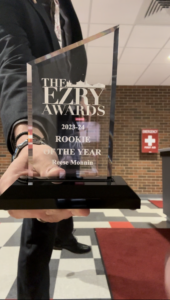Artis Leon Ivey, better known as Coolio, is a crazy-haired hidden gem of the ‘90s West Coast hip-hop genre. Though he was comparatively lesser known, and didn’t partake in the dramatic East Coast-West Coast rivalry, he garnered significant popularity for his hit single, “Gangster’s Paradise.”
Coolio adapted his moniker when he carried around guitars and would be derisively named Coolio Iglesias. He embraced the name Coolio and it stuck, becoming his stage name. He has released eight studio albums; his first three being his most successful and popular.
His debut album called “It Takes A Thief” was released in 1994. His entrance into hip-hop provided a refreshing take on gangster rap, often incorporating humor while discussing darker subjects. The success of one particular song, “Fantastic Voyage,” proved to be his breakout hit. Sampling from a synonymous funky hit from the early ‘80s, it proved to be popular with audiences. “Ghetto Cartoon” is his most creative song on the album. It masks a grisly episode in a gang war as interactions between famous cartoon characters, such as Bugs Bunny, Mickey Mouse and Donald Duck. The song “County Line” chronicles a day lying to social workers and dealing with annoying people while standing in a welfare line, despite his newfound success and popularity. Though this debut album helped Coolio break out, his next album would take his career to the next level.
With tons of momentum from the success of his previous album, Coolio worked himself more into the mainstream with his next album, “Gangster’s Paradise,” released in 1995. With this album, he gained the most popularity, due to the hit song of the same name. Lyrically, he chronicles the anxiety, anger and fear that accompanies living in gang-infested areas of town. This album also produced a popular party song called “1-2-3-4 (Something New).” He changed the sound up for the song “Ghetto Highlights,” which composed of a smoother guitar-based beat. He talks about the negative aspects of city ghettos and the challenge of escaping them. This album’s wild success made Coolio’s popularity peak, and left critics excited for more albums down the line. The album went on to be nominated for Album of the Year at the Grammys. Critics noted Coolio’s advocating of personal responsibility, which painted a picture of struggle, but also of hope.
The last album where Coolio had relative mainstream success was his third album called “My Soul,” released in 1997. Though he was hugely popular due to his two preceding albums, this third one didn’t quite succeed commercially, and caused him to fall out of mainstream success. The album wasn’t lacking in good music, but the mainstream audiences craved a more intense and hyped up sound while this album was relatively smooth and relaxed, leading to its lesser commercial success. The most successful song from this album is “C U When You Get There.” He discusses the need for the black community to be more peaceful toward one another, while the sound utilizes the heavy usage of violins. The song “Nature of the Business” talks about attempts to make quick cash with illegal activity, while trying to dodge the heavy risks and dangers of doing so.
Though Coolio didn’t reach the widespread popularity he deserved, he infused catchy g-funk sounds with tales of hardship, responsibility and hope. This provided for a unique and more thoughtful addition to the extensive catalog of ‘90s West Coast hip-hop.





